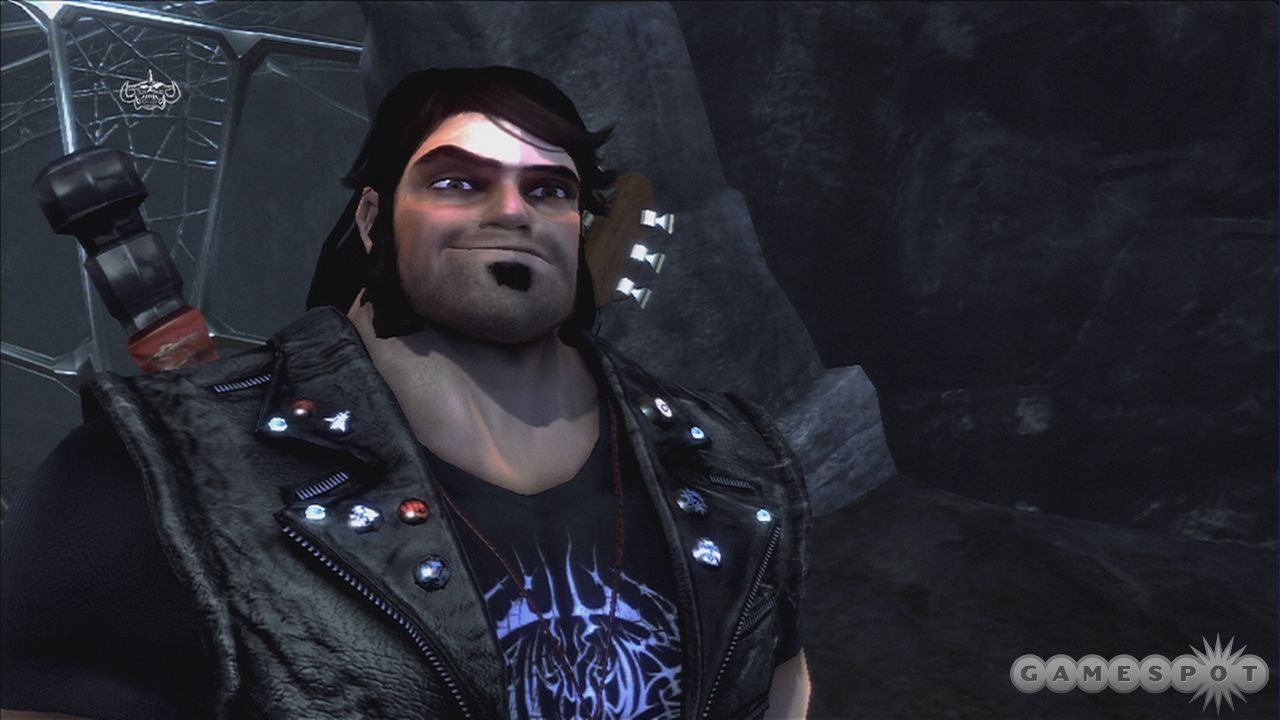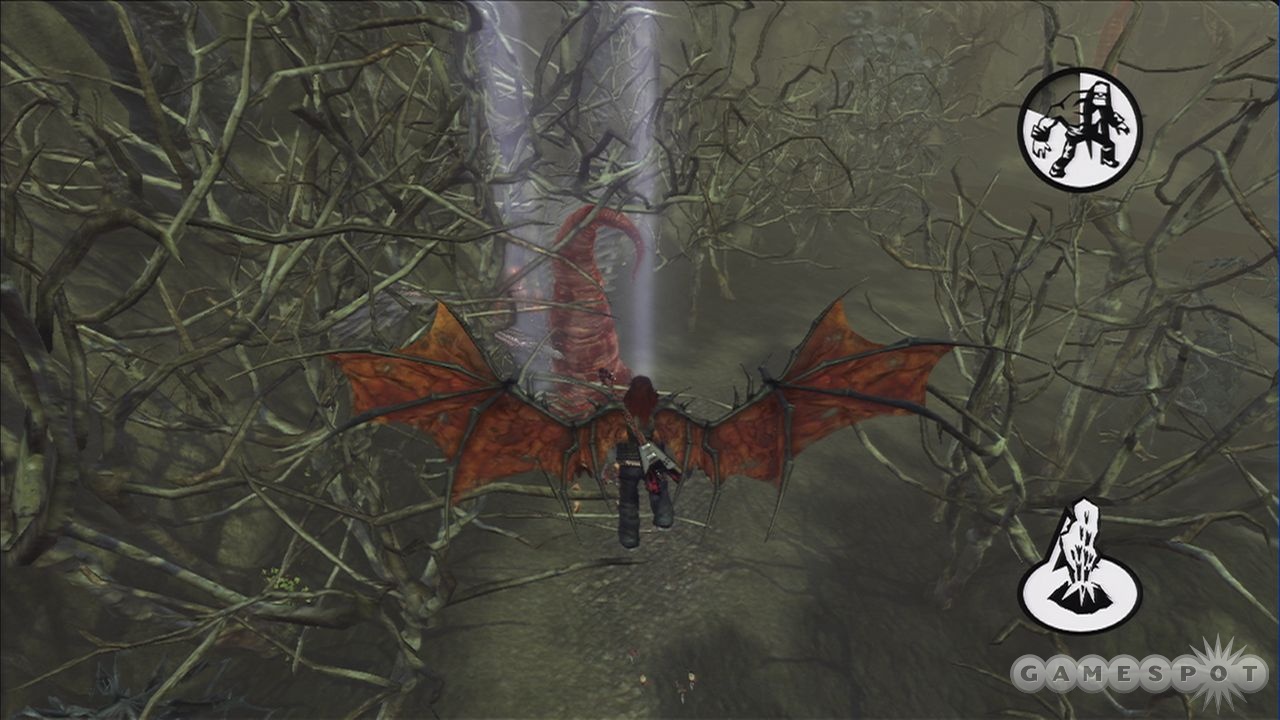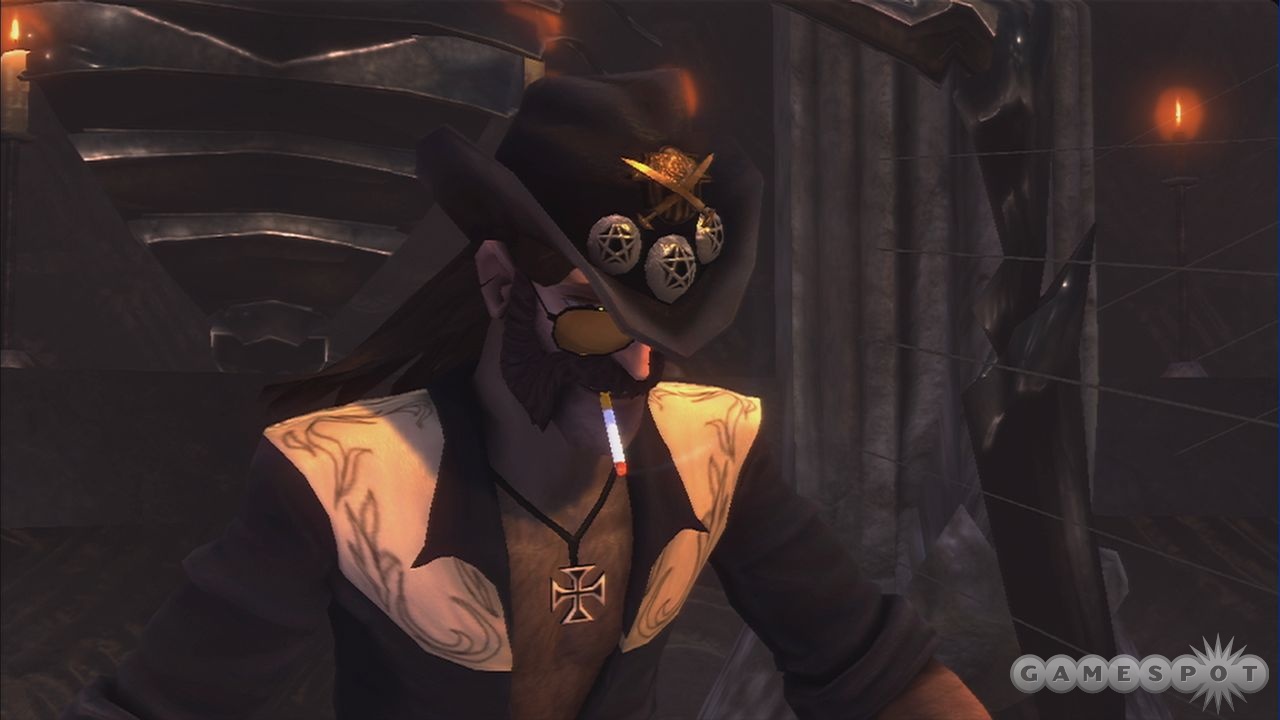Double Fine's Brutal Legend is an unabashed love letter to an era and genre of music that celebrated fast guitar riffs and hard living. It's also a tribute to an epic lore that spoke of conquerors and death--all of which were often depicted at once on any given metal album cover with the obligatory smattering of lightning. Of course, the fact that Brutal Legend features a phenomenal soundtrack from the likes of Black Sabbath, Motorhead, and Judas Priest with suitable hack-and-slash action would feasibly constitute a reasonable tribute on its own terms. Yet, what raises Brutal Legend above that simple construct--plus what makes it a great ode to metal--is how it cleverly integrates so many different facets of the culture and its music to create an experience that consistently entertains and surprises in both single-player and multiplayer.
But it should come as no surprise to those familiar with Double Fine's previous work with Psychonauts that Brutal Legend's characters and its story are the primary highlights. Eddie Riggs, a roadie who remembers and worships the glory days of metal, serves as a perfect lead character who's magically transported to a world that ostensibly reflects his own image of heaven. This world is a vast place where enormous, crumbling statues and smaller, skull-encrusted shrines pay homage to the gods and titans that brought metal and its music to the land. Naturally, there's a heavy dose of irony involved in this setup, which gives Jack Black (who voices Riggs) plenty of room to do his funny--albeit expected--trademark sarcasm-laden, observational routine. But his act rarely gets old or overwhelming because Riggs, as a character, often humbles himself in an endearing way despite finding himself in a position of leadership. He never loses sight of his roots as a roadie, and as such, he is there to help people who have fallen under the oppressive boot of the demonic Emperor Doviculus and his human warlord General Lionwhyte (voiced by Judas Priest frontman, Rob Halford), who also happens to symbolize a not-so-subtle jab at hair metal.
Secondary characters are often just as entertaining and memorable as Eddie Riggs. Ozzy Osbourne gives an amazing (and surprisingly coherent) performance as the Keeper of Metal, a storekeeper of sorts dwelling within special monuments dotted around Brutal Legend's open-world landscape. He sells upgrades for attacks, as well as Eddie's various pieces of equipment, including his battle axe, guitar, and his vintage roadster--the Deuce. There's an equally amusing, if not subdued, performance by Motorhead's lead singer Lemmy, who--as The Killmaster--functions as a healer for Eddie's army of headbangers. Sure, part of what makes these characters so delightful is that they are just fantastical representations of their on-stage personas, but even those characters that aren't voiced by real-world gods of metal do their part to balance out the star power, and they do it well. For example, Magus, a dimwitted stage engineer, provides an extra bit of laughs when Eddie's engaged in more serious affairs.
These characters and the story they tell are major reasons to keep playing through Brutal Legend's single-player campaign, but there's also plenty of good action to be had despite some shortcomings. The game is set up in an open-world structure that lets you set the pace of progression, so you can either stick to Eddie's main mission to defeat Doviculus and Lionwhyte or drive around in the Deuce to find secondary missions that are easily found using an in-game map. At first, the motivation for taking the secondary route is pretty clear. Every completed mission rewards you with fire tributes, or points, that function as the game's currency, and because secondary missions are usually pretty easy and don't require much time, this is a quick way to make a substantial amount of cash. You can then visit The Keeper of Metal and exchange points for aforementioned weapon, combination, and vehicle upgrades--additional items unlock as you venture deeper into the game.

But at a certain point, perhaps even just a few hours in, the motivation to engage in Brutal Legend's equivalent to level grinding wanes, and the reasons are clear. First, most secondary missions share the same objectives, so it doesn't take long for all of the ambush, race, and defend-this-point scenarios to get old. Secondly, you can purchase most of the useful upgrades relatively early in the game, which makes these missions even less enticing. In fact, by the end of the game, you may find yourself purchasing upgrades just to check them out, never to use them again. There are some exceptions to the tedium in the secondary missions, though, including a run-in with a bat that has a human head resembling Ozzy Osbourne in his earlier years, but Brutal Legend's side missions would've benefited greatly from more of these kinds of scenarios and fewer of the cookie-cutter options.
Conversely, its primary campaign does a much better job of breaking up different mission types and mixing in action that plays to its different mechanics. Granted, there are a couple of dreaded escort missions where you have to follow your army's tour bus from one location to another while fending off enemies, but these aren't all that difficult as long as you keep an eye on where enemies spawn. Eddie also has to go on foot into unknown areas for some missions, relying only on his axe for close combat and his guitar for long-range lightning and fire strikes. It's in these moments that you also learn to use some of his other skills, specifically guitar solos.
These solos, which you can unlock by finding shrines, function as special moves for Eddie. They allow him to melt faces of nearby enemies, recruit new army members, negate an enemy's magic abilities, or even summon a massive burning zeppelin to crush enemies. Of course, you actually have to get the solo right (each solo has a different, miniature rhythm-game-like series of button presses), but the trick is that you can't use these solos all the time (some of them have a long cool-off period) and Eddie still takes damage from enemies while performing them. This adds a nice dynamic to an otherwise straightforward combat system, and the missions (along with their accompanying boss battles) where you have to rely on Eddie and his combat skills are thoroughly enjoyable, but it would've been great to have more of them.

Instead, Brutal Legend replaces what would ordinarily be more of these kinds of missions with stage battles--a recipe with hack-and-slash and real-time strategy as its ingredients. A good portion of Brutal Legend is a real-time strategy game, and surprisingly, it's one of the best console adaptations of the genre's mechanics in quite some time, though its multiplayer incarnation is definitely better than its single-player counterpart. To give some context: Stage battles usually occur when facing an important evil character in the game. Each side has access to what are essentially fountains of fans that you need to build merchandise booths over (by playing a guitar solo) in order to claim them as a resource for building additional "units." Building more merch booths and claiming more fans lets you not only summon more units, but also different types of units.
You can control these units in different ways, either by using various commands on the D pad (defend, attack, and move) or by taking to the air and setting waypoints via a marker that you can place just about anywhere in the level--a highly recommended move because it gives you a better overall strategic view. And yes, Eddie grows wings that let him fly and survey the battlefield, but in either case, you still have to be reasonably close to your units to issue these commands and ultimately make your way towards the final goal of destroying the enemy's stage. The single-player version of these battles does an excellent job of tying all of Brutal Legend's gameplay elements together in a real-time strategy scenario, barring some minor context-sensitive control problems when there are too many units crowding around you.
Still, aside from the final confrontation, most of these stage battles are won through brute force--making a mad dash for all of the fan fountains and throwing wave after wave of units at the enemy is usually enough for a victory on normal difficulty. But multiplayer stage battles are completely different beasts that require far more skill and strategy--trying to win these matches through strength alone often results in complete failure within minutes. In fact, these battles almost become games of chess where fan fountains and merch booths become the pieces on the board. You use some of them to advance and strengthen your forces while you sacrifice others to the enemy for the same purpose.
Indeed, diversionary tactics also play an important role for success because another player can easily drop in and see what you're doing at any given time. As such, it's important to send out different groups of units to various areas on the map at all times, using one to bait your enemy into thinking that's where your main attack is coming from while you have a stronger group of units taking another route. Sometimes it's worth it to throw a few units directly at an enemy's stage or to drop in yourself and wreak some havoc and fly back to safety; if only for distraction purposes while you adjust your strategy. And the great thing about all of this is that you can play as one of three different factions--each with wildly different units--and an evenly matched battle shouldn't last more than 20 minutes or so.
While multiplayer is genuinely the surprise hit of the Brutal Legend experience, the single-player mode does have many other notable qualities, including a great metal soundtrack. Some of the songs seem a little questionable given the theme of the game ("Rock of Ages" is a great song, but doesn't seem like it belongs), and it's great that you can listen to anything while driving the Deuce around. But the soundtrack truly shines when it's obvious a specific song was chosen for a specific mission. "Through the Fire and Flames" by DragonForce is perfect for its intended sequence as is Nitro's "Machine Gun Eddie." There's a little bit of everything here on the spectrum, but to be fair, if metal's not really your thing, you might find it a little grating.

But one thing that should appeal to just about anyone is Brutal Legend's visual style. It's not necessarily a technical powerhouse in terms of special effects, but it more than makes up for it with cool-looking characters and varied environments that obviously had quite some thought and detail put into them. One particularly cool location is near the Sea of Black Tears--a gothic-inspired area decorated with candelabras and dilapidated cathedrals. But no matter where you are in the world, there's always some cool object to look at, whether it's a massive guitar statue sticking out of the ground or some a gigantic wall of amps where seagulls with microphones for heads fly. Unfortunately, there are some hiccups in the frame rate here and there, particularly when you're driving around or when there's a bit too much happening in a stage battle, but otherwise it remains rock solid throughout the game.
Whether it's excellent vocal performances from heavy hitters of metal or a strong multiplayer element, Brutal Legend is a game that continually surprises, and it does so in a genuinely fun and interesting way. And Double Fine deserves some major respect for keeping so many aspects of the game closely tied to its subject matter. Of course, Brutal Legend also has some shortcomings. The secondary missions are weak and the single-player campaign lasts about seven hours if you're not too keen on unlocking every single last shrine or secret item. In that respect, it's unfortunate that there's just not more of the good stuff, such as the on-foot missions with boss battles or more fleshed-out side quests. Otherwise, Brutal Legend is just about the finest tribute to this genre of music that a fan could hope for, and its successful execution of real-time strategy elements in an action setting is something that should get everyone off their feet and clapping.